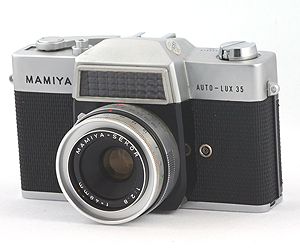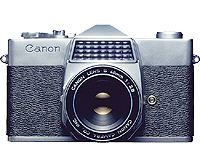|
 |
|
Home
What's New
About Me
Rangefinders
Prismat
TL & DTL
XTL & X-1000
MSX & DSX
NC-1000
Z-Series
Other Mamiya
Instruction
Manual
Reprints
Related Links
Mamiya
35mm Camera
Auction
Prices
Mamiya
SLR Lenses
Auction
Prices
Rest of
Collection
FAQ
Mamiya 35mm
Forum!
How To!


Your donations
help fund this site.
Thanks for your
continued support!
|
|
Mamiya 35mm Information
The fixed-lens series of Mamiya 35mm cameras were
produced and marketed for the the hobbyist, who was only concerned
with a good snapshot. Not that there is anything wrong with that.
The vast majority of picture-takers would probably fit in this category.
It's just that most of these cameras are never going to be noted
as the most critical photographic equipment Mamiya ever produced.
Still, for the most part they had decent optics, took decent pictures,
filled a need and sold well. Technical reviews about them are
scare, so any Gentle Reader who has information,
please join the
Collecting Mamiya 35mm Forum and tell us about it!
|
|
Mamiya Auto-Lux
35
The Mamiya Auto-Lux 35 was introduced in 1963.
A 35mm leaf-shutter SLR with a large selenium cell above the lens,
it has a manual match-needle or shutter-preferred auto exposure
control. It was sold with a fixed (non-interchangeable) 48mm Mamiya-Sekor
f/.8 lens in a Copal-X shutter, with speeds from 1/15-1/500 second.
It was also sold in Germany as the Revue Auto-Lux 35 by
Foto-Quelle or the Porst Autoflex by Porst.
Canon distributed a similar model known as the Canonex,
also in 1963. It was their first automatic exposure camera,
and the similarity to the Mamiya Auto-Lux is striking. It is
believed to have been produced under contract for Canon by
Mamiya. But because of the scarcity of records, there is still
an ongoing debate about which of the two companies was the
actual designer and manufacturer.
Peter Dechert, the noted Canon historian, wrote an
interesting
article about the Mamiya/Canon production
arrangement, talking about who made what and sold it to whom,
which supposedly also involved Osawa.
All that aside, the Canonex was not a successful camera and production
lasted less than nine months, ending in 1964. Ironically, its short-lived
production cycle makes the Canonex somewhat of a rare camera, sought after by
collectors today. No known records exist of Mamiya Auto-Lux production, but it
is known to have been produced for several more years.
|

Mamiya Auto-Lux 35, c.1963 R. Herron Collection

Canon's short-lived Canonex, produced
by Mamiya, c.1963
Photo courtesy Canon, Inc. |
|

Mamiya Family SLR, c.1962 R. Herron Collection

Mamiya Family
meter indication on top panel
near rewind crank
|
Mamiya Family
The Mamiya Family is an economy model lens-shutter
SLR first released in June 1962. It features a quick return mirror,
and a fixed (non-changeable) Mamiya-Sekor 48mm f/2.8 - f/22 lens
with an automatic (two element) aperture and Copal shutter, featuring
speeds from 1/15 to 1/250, and a B setting.
It has a built-in selenium exposure meter, which
is not coupled to either the shutter-speed dial or the f-stop ring.
The meter's needle indication is read on the camera's top surface,
near the rewind crank, and transferred manually to the camera. A
manual shot counter is on top, near the film advance. A popular
camera in its day, many of them can still be found in workable
condition. They are not considered particularly rare, but no
serious Mamiya collection would be complete without an example.
It was fairly popular in England, where it was also
sold as the Mamiya Korvette by B. Bennett & Sons, Ltd.,
and as the Mamiya Saturn by Dixons Photographic Ltd. All
the literature I have seen indicates the Saturn and Korvette were
equipped with the Mamiya-Kominar 48mm lens, which was not the sharpest
lens Mamiya ever produced. I have seen several comments written
about it as prone to flaring.
However, Gentle Reader Maurice Fisher, who lives near Worcester
in the UK, has written to say the Mamiya Saturn he owns has a Mamiya-Sekor
lens. So did the one he owned in 1964, which seems to indicate both
the Saturn and Korvette were marketed with a lens option. In spite
of a few negative comments, most users have been very complimentary
about the camera (Maurice indicated both of the ones he owned worked
well) and the pictures it provided for them!
|
|
Mamiya 528TL
Another economy fixed-lens SLR, the Mamiya 528TL
was released in 1967. It features a built-in behind-the-lens meter
(a spot meter with approximately a 10-degree center spot; needle
visible in the viewfinder), with a fully automatic aperture and
hot shoe.
The shutter-priority AE lens is a fixed 48mm f/2.8
with Copal shutter, with a filter size of 52mm. Speeds from 1/15-1/500
including a B-setting. It can be found with either Mamiya or Mamiya/Sekor
markings. It was also marketed in the USA as the Sears Auto 35TL.
Auxiliary lens sets, designed to screw onto the lens ring,
much like a filter, were sold as options to provide wide angle and telephoto
effects (accessory lenses were also made by Vivitar). They changed the normal
48mm focal length to 35mm (covering an angle of view of 63-1/2°)
and 62mm (38-1/2°), respectively.
The 528TL, although not among the most critically
acclaimed pieces of photographic equipment Mamiya produced, was
reasonably popular, took fairly adequate pictures and is still available
today at fairly modest prices. It uses one MS76 1.5v battery.
Click here for an
interesting online repair article about the Mamiya 528TL.
|

Mamiya 528TL, c.1967 R. Herron Collection

Mamiya Wide & Tele Accessory Lenses
|
|
Mamiya 528AL
The Mamiya 528AL was first released in 1975.
Another inexpensive camera similar to the earlier 528TL, it provided
manual focus, with a fixed 48mm f/2.8 lens in a Copal-X leaf shutter.
The same accessory wide angle and telephoto lenses that worked on
the 528TL were also available for the 528AL.
However, unlike the TL, which was a shutter priority
AE with a spot meter, the 528AL provides an averaging meter with
the f-stop range visible (needle) in the finder. Like the 528TL,
it also uses one MS76 (or equivalent) battery.
|

Mamiya 528AL, c.1975 R. Herron Collection |
© 2000-2010 R.L. Herron
All Rights Reserved. Legal
|
